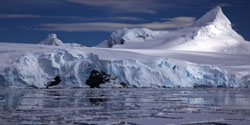Syracuse Views Fall 2025
We want to know how you experience Syracuse University. Take a photo and share it with us. We select photos from a variety of sources. Submit photos of your University experience by sending them directly to Syracuse University News at…

 To understand the present, scientists look for ways to unlock information about past climate hidden in the fossil record. A team of scientists led by Syracuse University geochemist Zunli Lu has found a new key in the form of ikaite, a rare mineral that forms in cold waters. Composed of calcium carbonate and water, ikaite crystals can be found off the coasts of Antarctica and Greenland.
To understand the present, scientists look for ways to unlock information about past climate hidden in the fossil record. A team of scientists led by Syracuse University geochemist Zunli Lu has found a new key in the form of ikaite, a rare mineral that forms in cold waters. Composed of calcium carbonate and water, ikaite crystals can be found off the coasts of Antarctica and Greenland.